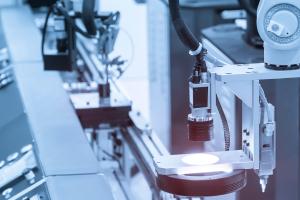Leveraging the strengths and technologies from both El-Mul and Photonis in the fields of high-performance ion, electron, and photon detection, we excel in collaborating with customers to tailor detector designs that precisely meet their instrument requirements.
More information about our leading technologies for Ion and Electron detection can be found on this page.

El-Mul is serving OEM vendors in the fields of analytic SEM and STEM, focused ion beam, mass spectrometry, semiconductor inspection and metrology

Photonis manufactures and sells technologies in the field of photo-detection and low light conditions imaging.
Photonis and El-Mul Time-of-Flight Detector Technology
Time-of-Flight (TOF) Mass Spectrometers (TOF-MS) operate on the principle of measuring the time it takes for ions to travel a fixed distance in an electric field. In a typical setup, ions are accelerated by an electric field towards a detector. The velocity of each ion is directly proportional to its mass-to-charge ratio. Lighter ions reach the detector faster than heavier ones. As the ions land on the detector, their arrival times are recorded, and the resulting data is used to construct mass spectra. TOF-MS offers high sensitivity and a wide mass range, making it valuable in various applications, including analyzing complex mixtures and identifying unknown compounds in fields such as chemistry, biology, and environmental science.
Photonis and El-Mul offer a portfolio of TOF detection platforms, each with distinct functionalities. One common approach, the Photonis BPTOF, couples a Microchannel Plate (MCP) to a scintillator and then to a Photomultiplier Tube (PMT). When ions strike the surface of the MCP, the electrical signal is amplified as freed electrons collide with the channel walls of the MCP. These electrons are focused onto a scintillator, which produces photons. These photons from the scintillator are focused onto a photocathode in a PMT. The photocathode converts photons back to electrons and the electrons are subsequently multiplied by secondary emission in the dynode stage of the PMT. This electrical signal emanating from the PMT is sent to the data acquisition system.
Another popular detection platform employed by TOF instrument manufacturers utilizes El-Mul’s MTOF concept. Ions are directed down the flight tube and collide with a flat conversion plate. Secondary electrons from the converter plate are focused onto ScintiFast™, an ultra-fast inorganic scintillator, converting them to photons. These photons then travel through a light guide into a photon sensor, which amplifies the signal which can be processed by the data acquisition system.
The stability and reproducibility of Photonis and El-Mul TOF Detection Platforms decreases the need for calibration and tuning, increases instrument uptime and maximizes day-to-day reproducibility. These detector attributes reduce cost of ownership, improve data quality and allow data integration – not only month-to-month but laboratory-to-laboratory.
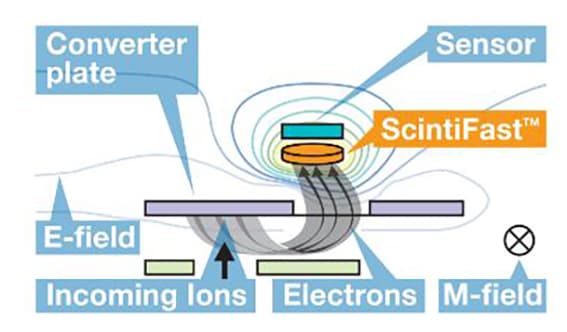
Photonis and El-Mul Quadrupole Detector Technology
A Quadrupole Mass Spectrometer is a crucial component in Mass Spectrometry, designed to separate and analyze ions based on their mass to charge ratio. Comprising of four parallel rods, the analyzer applies a combination of radio frequency and direct current (DC) voltages to create a stable quadrupole field. Ions with specific mass-to-charge ratios traverse this field, experiencing stable trajectories while others are selectively filtered out. By adjusting the voltages, only ions within a defined mass range reach the detector, allowing for precise identification and quantification of compounds in a sample. This dynamic sensitivity and high-resolution capability make quadrupole mass analyzers indispensable tools in various scientific fields, including chemistry, biology, and environmental science.
Quadrupole Mass Spectrometers commonly use continuous dynode electron multipliers to detect ions that have been separated by the mass analyzer. Molecules are ionized, focused, filtered through a mass analyzer, then focused into the detector. An ion striking the input face of the CEM typically produces 2-3 secondary electrons. These electrons are accelerated down the channel by a positive bias. The electrons strike the channel walls, producing additional electrons (and so on) until, at the output end pulse of 107 to 108 electrons emerges. This pulse of electrons is processed by the data acquisition system.
An alternative detection platform, El-Mul’s Vega technology, had the ions from the mass analyzer striking a conversion dynode. Secondary electrons generated at the dynode are pulled onto a scintillator, converting them to photons. Photons collected via a light guide are then detected by a PMT which amplifies the signal. The Vega detection platform provides the advantage of gain stability, reducing need to recalibrate or exchange detectors and increasing instrument uptime.
At its core, Ion & Electron detection technology focuses on the precise and sensitive detection of charged particles such as ions and electrons, as well as photons, which are fundamental building blocks in the study of matter and energy. These charged particles carry valuable information about the properties and interactions of substances, making their accurate detection essential in numerous scientific research.
Ion and Electron Detector Types
Electron Multipliers as a Technology
As the name implies, the role of an electron multiplier is to multiply (or amplify) a detected ion or electron signal to a level in which it can be processed into data.
Electron multipliers rely on the principles of "dynodes" and "secondary emissions". A "dynode" is simply an electrode within a vacuum that emits electrons when an ion or electron with sufficient m/z (mass to charge) ratio and kinetic energy strikes the surface of the inner channel walls of an electron multiplier. The emitted electrons from this process are called “secondary emissions”. Electron multipliers string together a series of these dynodes (continuous dynodes) so that the process of secondary emission happens repeatedly, amplifying the number of electrons exponentially at each step along the way.
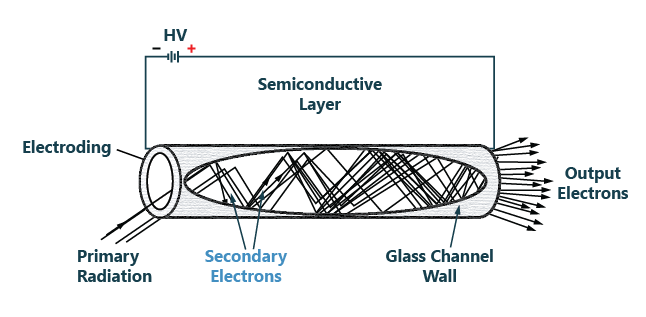
Microchannel Plates
A Microchannel Plate is an array of miniature electron multiplier channels, each acting as a continuous dynode chain. The compact channel structure results in high spatial and time resolutions and robustness to magnetic fields.
For more than 40 years, Photonis has led the industry in electron multiplication products with Microchannel Plate technology. Today, Long-Life™ Microchannel Plates are setting the industry standard for performance and lifetime. Unrivaled expertise in designing and manufacturing MCPs ensures that customers receive the most sensitive and reliable amplification devices available. Photonis specializes in providing MCPs in custom formats to fit specific instrument requirements.The table shows some of Photonis’ capabilities:
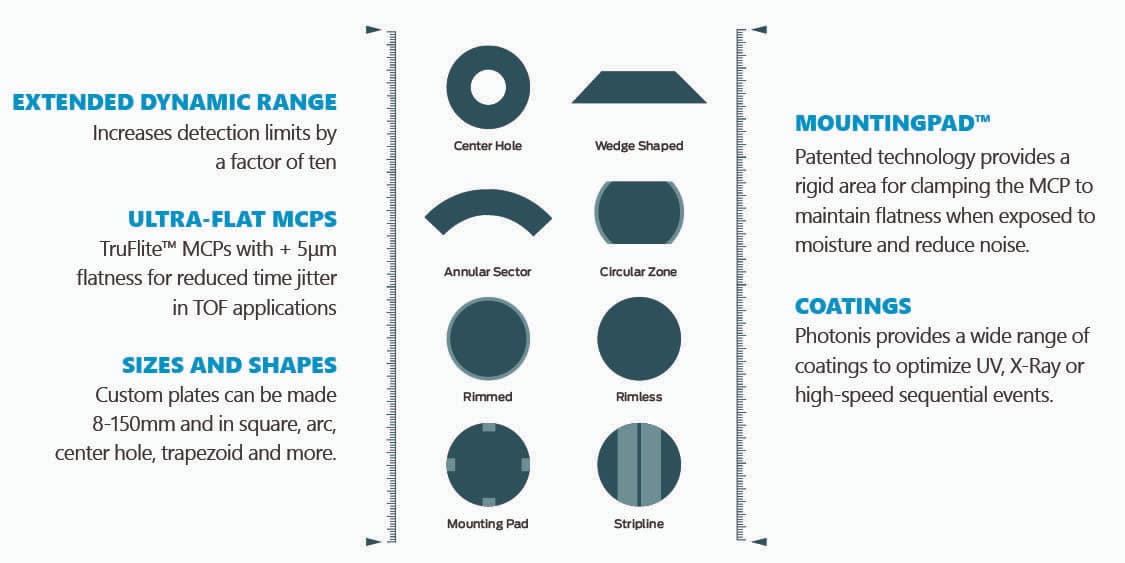
MCP Based Detectors (Advanced Performance Detectors)
Each Photonis MCP-based detector is designed with LongLife™ Microchannel Plates, which provide the highest level of sensitivity available to the market. These complete detector assemblies can be used in a wide variety of applications to detect charged particles and electromagnetic radiation, ranging from Mass Spectrometry to UV and X-Ray Astronomy. The detectors are designed for use in vacuum systems and continue to operate efficiently in elevated temperature conditions (300°C – the temperature reached during chamber cleaning) therefore saving time that would otherwise be required to remove the detector from the instrument.
Channeltron™ Channel Electron Multipliers
Channeltron™ Channel Electron Multipliers (CEMs) use the same operating principle as Microchannel Plates but are designed to operate using a single channel for electron multiplication rather than an array. Photonis has a wide variety of Channeltrons™ constructed from a specially formulated glass developed and produced in-house. Due to their low mass and high gain, Channeltrons® are also used in many nuclear physics labs and space applications to count electrons and charged particles in pulse mode operation. Other applications include residual gas analysis, plasma analysis, Auger, electron spectrometers, SEM, FIB and leak detectors.
Detectors for electron microscopy and e-beam systems
Exosens offers a variety of detection platforms for electrons and ions, applicable for scanning electron microscopes, transmission electron microscopes, focused ion beam tools and e-beam systems for the semiconductor industry.
Scintillator-based electron detectors attract electrons to a scintillator plate, which creates an amplified photon signal. The photos are then directed to photon sensor which converts the signal back to electrons and amplifies it.
This basic detection scheme can be implemented with a variety of scintillators and a variety of photon sensors. A traditional implementation is the Everhart Thornley detection scheme often used to detect secondary electrons in SEM chambers and provide a topographic image of the specimen.
A more advanced implementation is an in-column backscattered electron (BSE) detector which can filter out low energy electrons and provide a clean BSE signal, giving material-contrast in the SEM’s image.
Other implementations split the signal into several segments and use ScintiFast™, and ultra-fast inorganic scintillator, to support fast scanning and imaging. Such implementations are common for metrology and inspection e-beam systems in the semiconductor industry.
Solid state detection technology is also available. This technology allows for flexible design and segmentation of the detector’s active area. It is frequently used for BSE detectors and for transmitted electron detectors in both SEMs and high energy scanning transmission electron microscopes (TEM).

Enhancing Scientific Instrumentation
In the realm of high-performance particle detectors, Ion & Electron detection technology offers unparalleled sensitivity and efficiency. It allows researchers to amplify and detect even the tiniest quantities of ions, electrons, and photons, enabling a deeper understanding of the underlying principles governing natural phenomena. This heightened sensitivity is particularly crucial in space projects, where the detection of cosmic radiation and particles from distant celestial bodies can provide valuable insights into the universe’s composition and evolution.
Empowering Research in Material Analysis
Furthermore, Ion & Electron detection technology significantly contributes to scientific instrumentation. Its ability to amplify signals from charged particles allows for the development of sophisticated instruments with enhanced spatial and temporal resolution. This enables scientists to conduct more precise experiments, leading to breakthroughs in fields such as particle physics, nuclear research, and analytical chemistry.


Applications in Life Sciences and Non-Destructive Testing (NDT)
Ion & Electron detection technology also finds applications in life sciences, where it aids in cellular analysis. By detecting and amplifying ions and electrons at the cellular level, researchers gain valuable insights into cellular processes, disease mechanisms, and potential therapeutic targets. Moreover, this technology facilitates material analysis, supporting the study of material properties and characteristics, thereby contributing to the development of novel materials with various practical applications.
The continuous advancement of Ion & Electron detection technology has opened up new possibilities in non-destructive testing (NDT) as well. With its ability to accurately amplify and detect charged particles, this technology allows for thorough inspections without causing damage to the tested materials. Consequently, it ensures the safety and reliability of structures and components in various industries, safeguarding against potential failures and hazards.
Opening new frontiers in scientific research
Ion & Electron detection technology represents a crucial frontier in the field of high-performance particle detectors. Its exceptional sensitivity and capabilities in amplifying and detecting ions, electrons, and photons have broad applications, ranging from space exploration to life sciences and material analysis. By enabling precise and efficient detection solutions, Ion & Electron detection technology empowers researchers to uncover new insights into the mysteries of the universe and make significant contributions to scientific knowledge and technological advancements.
At Exosens, we are proud to be at the forefront of Ion & Electron detection technology and its applications. Leveraging our expertise and cutting-edge research, we offer a range of leading technologies that have been meticulously designed to address the most demanding scientific challenges. Our custom-designed detectors and components cater to the unique needs of various scientific instruments, providing researchers with unrivaled tools for exploration and discovery.

Products 7
See all exosens products
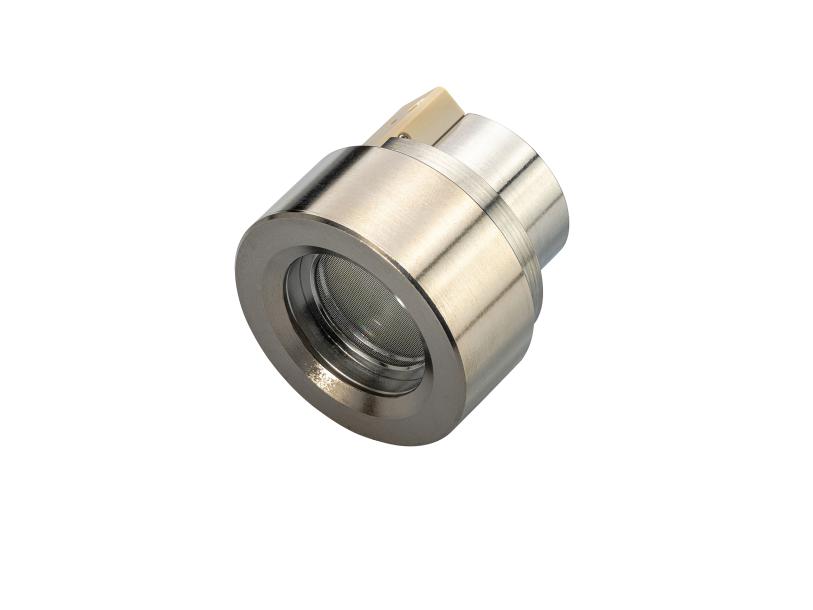

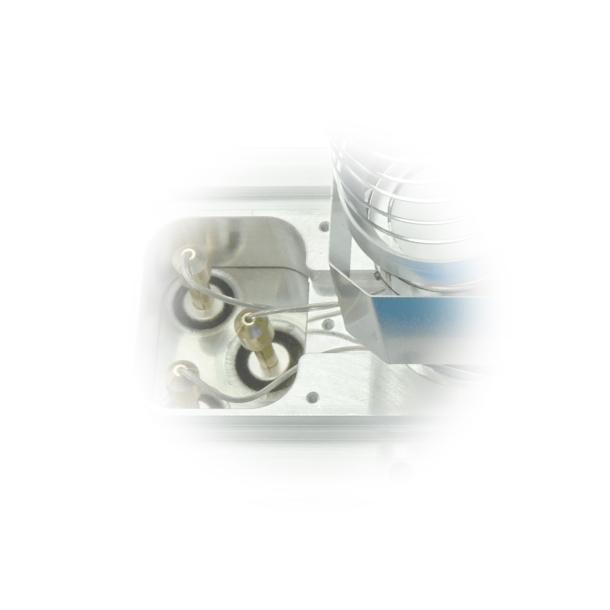


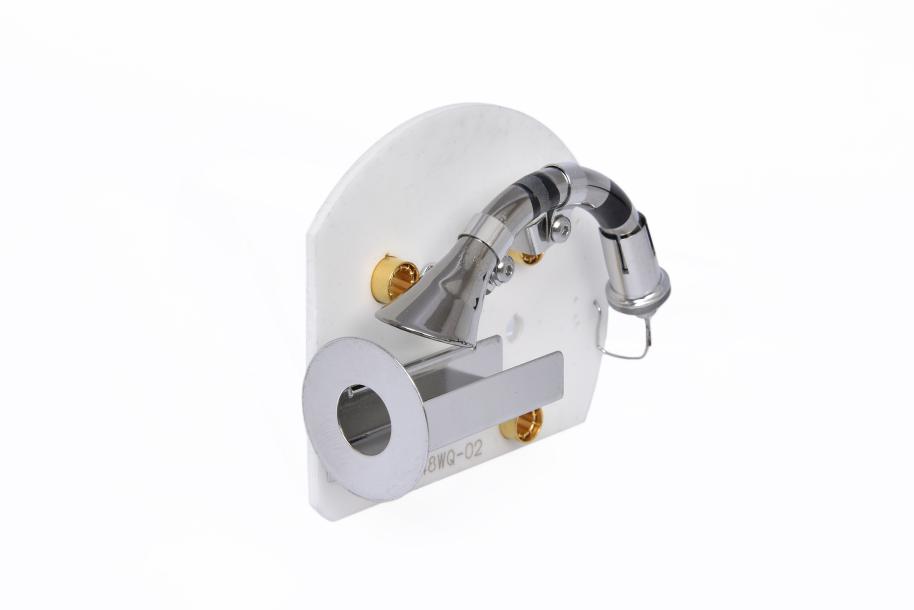

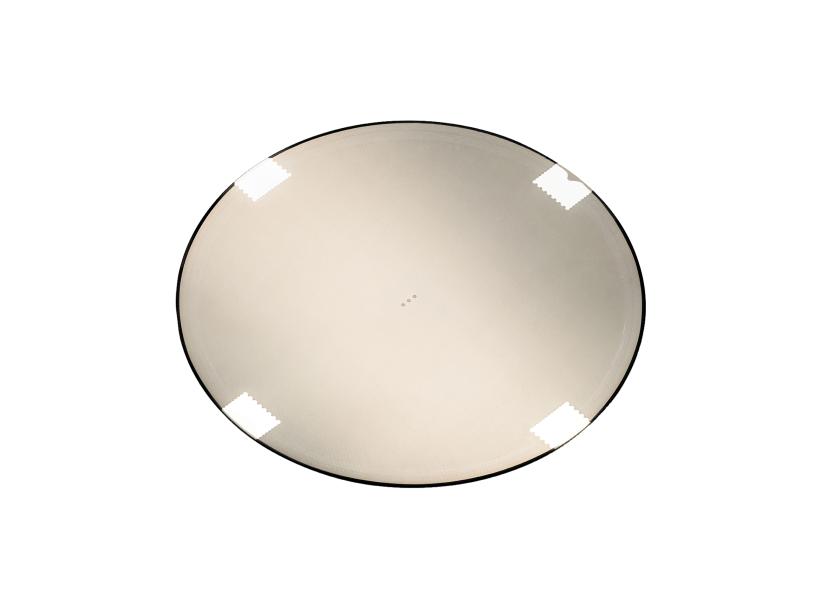

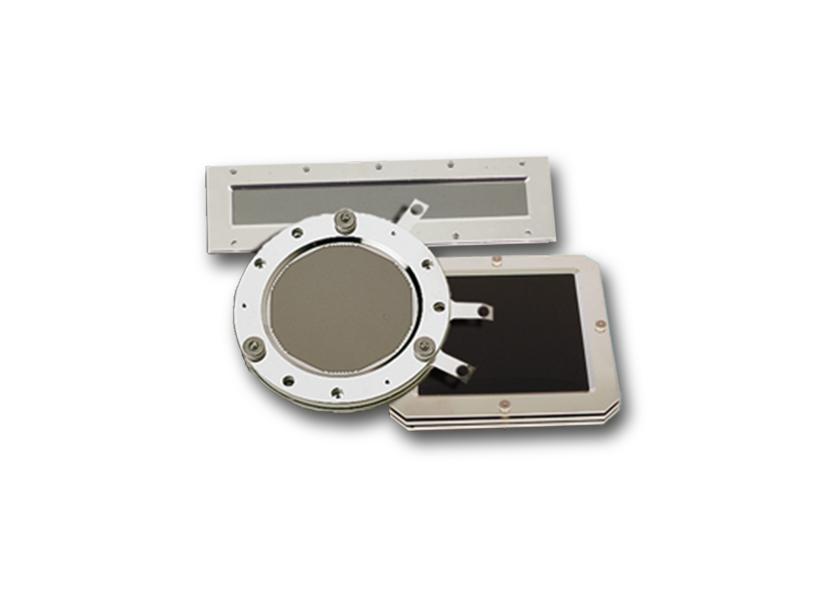

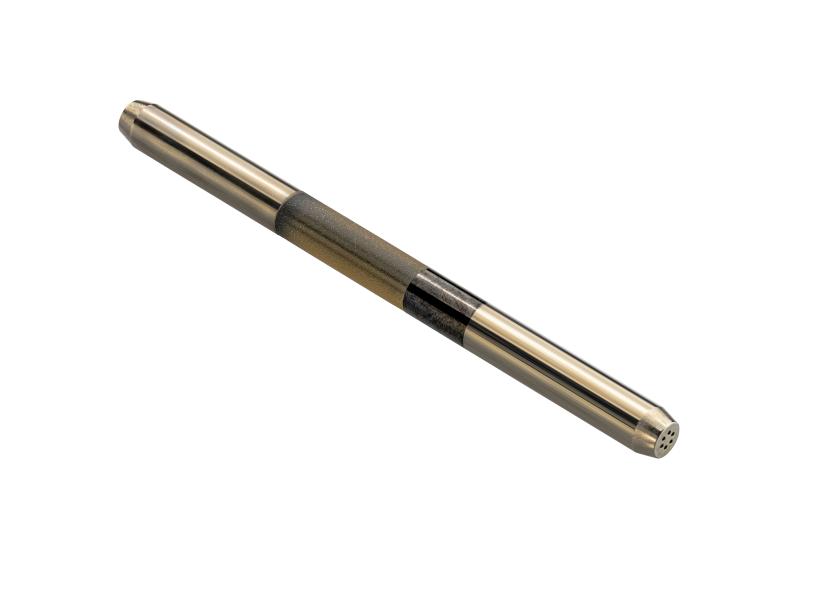
What's new in Ions & electrons detection technology?
See all

Anaheim Convention Center, Anaheim, California.
FROM Jun 02nd 2024 TO Jun 06th 2024
ASMS 2024
Visit Exosens at ASMS 2024 from 2 to 6 June 2024 at the Anaheim Convention Center, Anaheim, California, USA.

Munich.
FROM Mar 09th 2024 TO Apr 12th 2024
Analytica 2024
Visit Exosens at Analytica 2024 from 9 to 12 April 2024 in Munich, Germany
